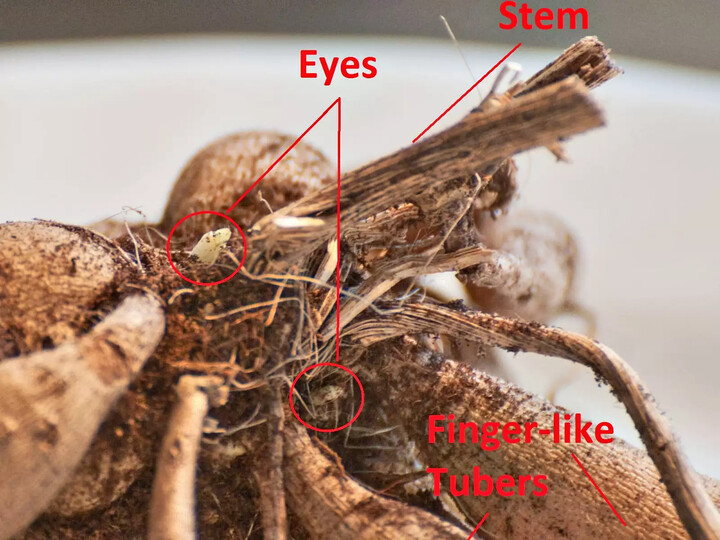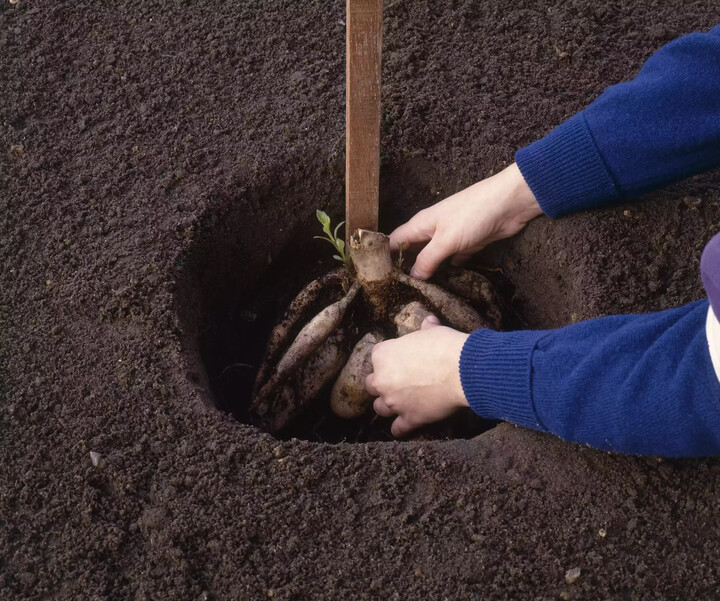Dahlias are a perennial plant that grow from tuberous roots. And like most tuberous flowers, it is easily propagated by digging up and dividing the roots.
Because dahlias are hardy only in zone 7 and higher, gardeners living in colder climates who want to keep their tubers must dig them up in the fall, and this also offers a good time to divide the roots. The division can be done either immediately before you store the tubers for winter or in the spring when the growth eyes are more visible. Spring division gives you the opportunity to discard any tubers that haven't survived the winter. In warmer climates where the tubers can remain in the ground, you can dig up, divide, and replant the tubers in early spring before growth has begun.
For this tutorial, we are dividing the tubers in a cold-weather scenario, allowing the foliage to die in the fall before digging up the dahlias for division and storage. It is typically a quick and easy task, depending on how many plants you have.
What You'll Need
Equipment / Tools
Pruners
Shovel or trowel
Sharp knife
Materials
Dahlia plants
Mesh storage bags
Nursery pot and soil (optional)
Instructions
1.Cut Back the Foliage
Wait until the plants have been hit by frost and begun to die back. Once the foliage and stems are turning yellow, the plant is ready to be dug up.
Cut the top growth down to about 4 to 6 inches. Then, leave the plant in the ground for another 10 to 14 days to allow it to cure and prepare itself for winter and for the new growth eyes to begin development.
2.Dig Up the Tubers
To lift the dahlias, begin digging about 1 foot away from the plant, loosening the soil. A shovel is generally better to use than a fork because there's less of a risk of stabbing the tubers. Once the soil is loosened, lift the plant out of the ground. The tubers have a tendency to snap off, so handle the plant gently. Carefully shake and brush off excess soil. You also can hose off the remaining soil for a better view of the eyes.

3.Divide the Tubers
Although a clump of dahlia tubers looks like multiple fingers, you can't just separate the fingers and grow more plants. Each dahlia division needs to have at least one eye and a nice, fat tuber.
The dahlia root clump typically has one large central tuber—the original tuber—as well as small offshoot tubers that developed during the growing season. This central tuber is normally discarded, as it has already expended its energy. It is the offshoot tubers that are used when dividing a dahlia. These offshoots don't typically have growth eyes, which are instead the white or pinkish dots located around the base of the stem. The eyes are the growing point where the stem will come from next year.
The goal when dividing is to separate the clump into sections, each including a part of the stem base with an eye and one or more offset tubers. Carefully examine the clump, and cut sections that include these features.
Allow the sections to dry out slightly in open air before storing. When the skins of the tubers just start to wrinkle, they are ready to be stored.

4.Store for Winter
Place the tubers in a mesh bag, and set them somewhere cool, dark, and sheltered. A temperature no higher than 50 degrees Fahrenheit is ideal for storing dahlia tubers for the winter. Allow them to get good air circulation, which will help to prevent rot.
Over the winter, periodically inspect the tubers. If any develop mold or rot, discard them. If they begin to send out vigorous growth shoots (this can happen in late winter), it's best to plant them in pots and grow them by a sunny window. Then, transplant them into the garden once the weather warms and all danger of frost has passed.
5.Replant the Dahlia Tubers
Whether it's into indoor nursery pots in late winter or into the garden in spring, dahlia tubers should be planted 4 to 6 inches deep. Lay the tuber horizontally with the eyes (or new green shoots) facing up. Loosely pack soil over them, and water lightly each day until shoots emerge from the soil. Avoid letting the soil dry out completely, but also avoid saturating it. Once ample above-ground growth is present, weekly watering should be sufficient.
